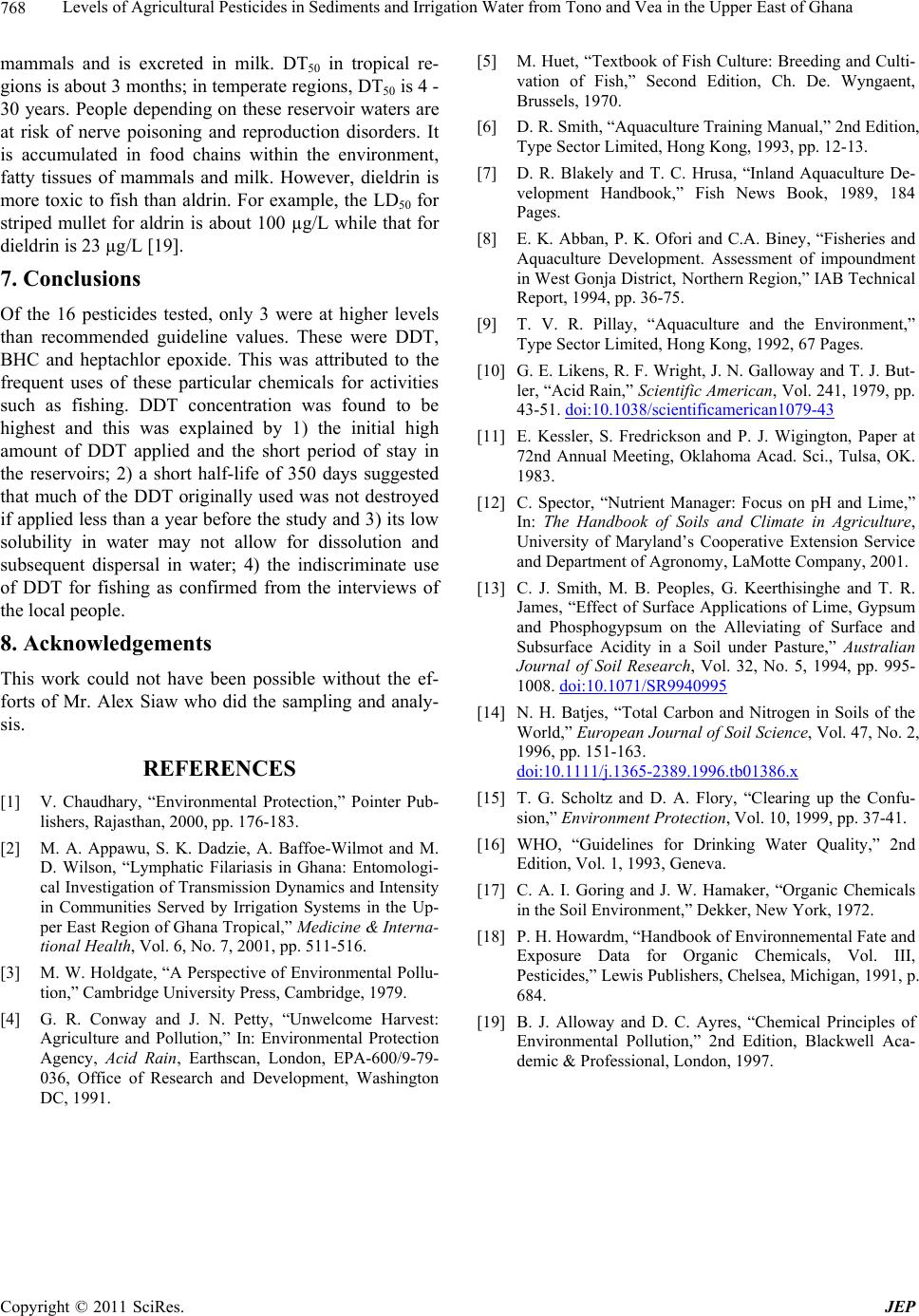
Levels of Agricultural Pesticides in Sediments and Irrigation Water from Tono and Vea in the Upper East of Ghana
768
mammals and is excreted in milk. DT50 in tropical re-
gions is about 3 months; in temperate regions, DT50 is 4 -
30 years. People depending on these reservoir waters are
at risk of nerve poisoning and reproduction disorders. It
is accumulated in food chains within the environment,
fatty tissues of mammals and milk. However, dieldrin is
more toxic to fish than aldrin. For example, the LD50 for
striped mullet for aldrin is about 100 µg/L while that for
dieldrin is 23 µg/L [19].
7. Conclusions
Of the 16 pesticides tested, only 3 were at higher levels
than recommended guideline values. These were DDT,
BHC and heptachlor epoxide. This was attributed to the
frequent uses of these particular chemicals for activities
such as fishing. DDT concentration was found to be
highest and this was explained by 1) the initial high
amount of DDT applied and the short period of stay in
the reservoirs; 2) a short half-life of 350 days suggested
that much of the DDT originally used was not destroyed
if applied less than a year before the study and 3) its low
solubility in water may not allow for dissolution and
subsequent dispersal in water; 4) the indiscriminate use
of DDT for fishing as confirmed from the interviews of
the local people.
8. Acknowledgements
This work could not have been possible without the ef-
forts of Mr. Alex Siaw who did the sampling and analy-
sis.
REFERENCES
[1] V. Chaudhary, “Environmental Protection,” Pointer Pub-
lishers, Rajasthan, 2000, pp. 176-183.
[2] M. A. Appawu, S. K. Dadzie, A. Baffoe-Wilmot and M.
D. Wilson, “Lymphatic Filariasis in Ghana: Entomologi-
cal Investigation of Transmission Dynamics and Intensity
in Communities Served by Irrigation Systems in the Up-
per East Region of Ghana Tropical,” Medicine & Interna-
tional Health, Vol. 6, No. 7, 2001, pp. 511-516.
[3] M. W. Holdgate, “A Perspective of Environmental Pollu-
tion,” Cambridge University Press, Cambridge, 1979.
[4] G. R. Conway and J. N. Petty, “Unwelcome Harvest:
Agriculture and Pollution,” In: Environmental Protection
Agency, Acid Rain, Earthscan, London, EPA-600/9-79-
036, Office of Research and Development, Washington
DC, 1991.
[5] M. Huet, “Textbook of Fish Culture: Breeding and Culti-
vation of Fish,” Second Edition, Ch. De. Wyngaent,
Brussels, 1970.
[6] D. R. Smith, “Aquaculture Training Manual,” 2nd Edition,
Type Sector Limited, Hong Kong, 1993, pp. 12-13.
[7] D. R. Blakely and T. C. Hrusa, “Inland Aquaculture De-
velopment Handbook,” Fish News Book, 1989, 184
Pages.
[8] E. K. Abban, P. K. Ofori and C.A. Biney, “Fisheries and
Aquaculture Development. Assessment of impoundment
in West Gonja District, Northern Region,” IAB Technical
Report, 1994, pp. 36-75.
[9] T. V. R. Pillay, “Aquaculture and the Environment,”
Type Sector Limited, Hong Kong, 1992, 67 Pages.
[10] G. E. Likens, R. F. Wright, J. N. Galloway and T. J. But-
ler, “Acid Rain,” Scientific American, Vol. 241, 1979, pp.
43-51. doi:10.1038/scientificamerican1079-43
[11] E. Kessler, S. Fredrickson and P. J. Wigington, Paper at
72nd Annual Meeting, Oklahoma Acad. Sci., Tulsa, OK.
1983.
[12] C. Spector, “Nutrient Manager: Focus on pH and Lime,”
In: The Handbook of Soils and Climate in Agriculture,
University of Maryland’s Cooperative Extension Service
and Department of Agronomy, LaMotte Company, 2001.
[13] C. J. Smith, M. B. Peoples, G. Keerthisinghe and T. R.
James, “Effect of Surface Applications of Lime, Gypsum
and Phosphogypsum on the Alleviating of Surface and
Subsurface Acidity in a Soil under Pasture,” Australian
Journal of Soil Research, Vol. 32, No. 5, 1994, pp. 995-
1008. doi:10.1071/SR9940995
[14] N. H. Batjes, “Total Carbon and Nitrogen in Soils of the
World,” European Journal of Soil Science, Vol. 47, No. 2,
1996, pp. 151-163.
doi:10.1111/j.1365-2389.1996.tb01386.x
[15] T. G. Scholtz and D. A. Flory, “Clearing up the Confu-
sion,” Environment Protection, Vol. 10, 1999, pp. 37-41.
[16] WHO, “Guidelines for Drinking Water Quality,” 2nd
Edition, Vol. 1, 1993, Geneva.
[17] C. A. I. Goring and J. W. Hamaker, “Organic Chemicals
in the Soil Environment,” Dekker, New York, 1972.
[18] P. H. Howardm, “Handbook of Environnemental Fate and
Exposure Data for Organic Chemicals, Vol. III,
Pesticides,” Lewis Publishers, Chelsea, Michigan, 1991, p.
684.
[19] B. J. Alloway and D. C. Ayres, “Chemical Principles of
Environmental Pollution,” 2nd Edition, Blackwell Aca-
demic & Professional, London, 1997.
Copyright © 2011 SciRes. JEP